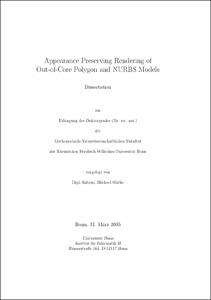Guthe, Michael: Appearance Preserving Rendering of Out-of-Core Polygon and NURBS Models. - Bonn, 2005. - Dissertation, Rheinische Friedrich-Wilhelms-Universität Bonn.
Online-Ausgabe in bonndoc: https://nbn-resolving.org/urn:nbn:de:hbz:5N-06176
Online-Ausgabe in bonndoc: https://nbn-resolving.org/urn:nbn:de:hbz:5N-06176
@phdthesis{handle:20.500.11811/2316,
urn: https://nbn-resolving.org/urn:nbn:de:hbz:5N-06176,
author = {{Michael Guthe}},
title = {Appearance Preserving Rendering of Out-of-Core Polygon and NURBS Models},
school = {Rheinische Friedrich-Wilhelms-Universität Bonn},
year = 2005,
note = {In Computer Aided Design (CAD) trimmed NURBS surfaces are widely used due to their flexibility. For rendering and simulation however, piecewise linear representations of these objects are required. A relatively new field in CAD is the analysis of long-term strain tests. After such a test the object is scanned with a 3d laser scanner for further processing on a PC. In all these areas of CAD the number of primitives as well as their complexity has grown constantly in the recent years. This growth is exceeding the increase of processor speed and memory size by far and posing the need for fast out-of-core algorithms. This thesis describes a processing pipeline from the input data in the form of triangular or trimmed NURBS models until the interactive rendering of these models at high visual quality. After discussing the motivation for this work and introducing basic concepts on complex polygon and NURBS models, the second part of this thesis starts with a review of existing simplification and tessellation algorithms. Additionally, an improved stitching algorithm to generate a consistent model after tessellation of a trimmed NURBS model is presented. Since surfaces need to be modified interactively during the design phase, a novel trimmed NURBS rendering algorithm is presented. This algorithm removes the bottleneck of generating and transmitting a new tessellation to the graphics card after each modification of a surface by evaluating and trimming the surface on the GPU. To achieve high visual quality, the appearance of a surface can be preserved using texture mapping. Therefore, a texture mapping algorithm for trimmed NURBS surfaces is presented. To reduce the memory requirements for the textures, the algorithm is modified to generate compressed normal maps to preserve the shading of the original surface. Since texturing is only possible, when a parametric mapping of the surface - requiring additional memory - is available, a new simplification and tessellation error measure is introduced that preserves the appearance of the original surface by controlling the deviation of normal vectors. The preservation of normals and possibly other surface attributes allows interactive visualization for quality control applications (e.g. isophotes and reflection lines). In the last part out-of-core techniques for processing and rendering of gigabyte-sized polygonal and trimmed NURBS models are presented. Then the modifications necessary to support streaming of simplified geometry from a central server are discussed and finally and LOD selection algorithm to support interactive rendering of hard and soft shadows is described.},
url = {https://hdl.handle.net/20.500.11811/2316}
}
urn: https://nbn-resolving.org/urn:nbn:de:hbz:5N-06176,
author = {{Michael Guthe}},
title = {Appearance Preserving Rendering of Out-of-Core Polygon and NURBS Models},
school = {Rheinische Friedrich-Wilhelms-Universität Bonn},
year = 2005,
note = {In Computer Aided Design (CAD) trimmed NURBS surfaces are widely used due to their flexibility. For rendering and simulation however, piecewise linear representations of these objects are required. A relatively new field in CAD is the analysis of long-term strain tests. After such a test the object is scanned with a 3d laser scanner for further processing on a PC. In all these areas of CAD the number of primitives as well as their complexity has grown constantly in the recent years. This growth is exceeding the increase of processor speed and memory size by far and posing the need for fast out-of-core algorithms. This thesis describes a processing pipeline from the input data in the form of triangular or trimmed NURBS models until the interactive rendering of these models at high visual quality. After discussing the motivation for this work and introducing basic concepts on complex polygon and NURBS models, the second part of this thesis starts with a review of existing simplification and tessellation algorithms. Additionally, an improved stitching algorithm to generate a consistent model after tessellation of a trimmed NURBS model is presented. Since surfaces need to be modified interactively during the design phase, a novel trimmed NURBS rendering algorithm is presented. This algorithm removes the bottleneck of generating and transmitting a new tessellation to the graphics card after each modification of a surface by evaluating and trimming the surface on the GPU. To achieve high visual quality, the appearance of a surface can be preserved using texture mapping. Therefore, a texture mapping algorithm for trimmed NURBS surfaces is presented. To reduce the memory requirements for the textures, the algorithm is modified to generate compressed normal maps to preserve the shading of the original surface. Since texturing is only possible, when a parametric mapping of the surface - requiring additional memory - is available, a new simplification and tessellation error measure is introduced that preserves the appearance of the original surface by controlling the deviation of normal vectors. The preservation of normals and possibly other surface attributes allows interactive visualization for quality control applications (e.g. isophotes and reflection lines). In the last part out-of-core techniques for processing and rendering of gigabyte-sized polygonal and trimmed NURBS models are presented. Then the modifications necessary to support streaming of simplified geometry from a central server are discussed and finally and LOD selection algorithm to support interactive rendering of hard and soft shadows is described.},
url = {https://hdl.handle.net/20.500.11811/2316}
}






